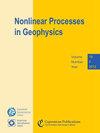概念海洋模型中估计committer函数的数据驱动方法
IF 2.4
4区 地球科学
Q3 GEOSCIENCES, MULTIDISCIPLINARY
引用次数: 4
摘要
摘要近年来,已经确定了几个气候子系统,与它们的强迫变化相比,它们可能经历一个相对较快的转变。这样的转换通常是罕见的事件,并且模拟足够长的轨迹以收集足够的数据来确定转换统计数据将过于昂贵。相反,像TAMS(轨迹自适应多级采样)这样的罕见事件算法在跟踪模型统计数据的同时鼓励过渡。然而,该算法依赖于一个分数函数,分数函数的选择对保证算法的效率至关重要。最优分数函数,称为提交者函数,在实践中很难计算。在本文中,我们比较了不同的基于数据的方法(模拟马尔可夫链,神经网络,油藏计算,动态伽辽金近似)从轨迹数据估计提交者。我们将这些方法应用于两种具有非常不同动力行为的大西洋环流模式。我们根据两个度量来比较这些方法,评估估计与真正提交者的接近程度以及计算时间。我们发现所有的方法都能够从数据中提取信息,以便提供对提交者的良好估计。模拟马尔可夫链在简单模型中提供了对真正提交者的非常可靠的估计,但在应用于具有更复杂相空间的系统时证明不是那么健壮。与其他方法相比,神经网络方法以其相对较低的测试时间而脱颖而出,并且其训练时间尺度更有利于模型的复杂性。特别是,前馈神经网络在有足够数据训练的情况下始终能获得最佳性能,这使得该方法有望用于复杂气候模型中的提交者估计。本文章由计算机程序翻译,如有差异,请以英文原文为准。
Data-driven methods to estimate the committor function in conceptual ocean models
Abstract. In recent years, several climate subsystems have been identified that may undergo a relatively rapid transition compared to the changes in their forcing. Such transitions are rare events in general, and simulating long-enough trajectories in order to gather sufficient data to determine transition statistics would be too expensive. Conversely, rare events algorithms like TAMS (trajectory-adaptive multilevel sampling) encourage the transition while keeping track of the model statistics. However, this algorithm relies on a score function whose choice is crucial to ensure its efficiency. The optimal score function, called the committor function, is in practice very difficult to compute. In this paper, we compare different data-based methods (analog Markov chains, neural networks, reservoir computing, dynamical Galerkin approximation) to estimate the committor from trajectory data. We apply these methods on two models of the Atlantic Ocean circulation featuring very different dynamical behavior. We compare these methods in terms of two measures, evaluating how close the estimate is from the true committor and in terms of the computational time. We find that all methods are able to extract information from the data in order to provide a good estimate of the committor. Analog Markov Chains provide a very reliable estimate of the true committor in simple models but prove not so robust when applied to systems with a more complex phase space. Neural network methods clearly stand out by their relatively low testing time, and their training time scales more favorably with the complexity of the model than the other methods. In particular, feedforward neural networks consistently achieve the best performance when trained with enough data, making this method promising for committor estimation in sophisticated climate models.
求助全文
通过发布文献求助,成功后即可免费获取论文全文。
去求助
来源期刊

Nonlinear Processes in Geophysics
地学-地球化学与地球物理
CiteScore
4.00
自引率
0.00%
发文量
21
审稿时长
6-12 weeks
期刊介绍:
Nonlinear Processes in Geophysics (NPG) is an international, inter-/trans-disciplinary, non-profit journal devoted to breaking the deadlocks often faced by standard approaches in Earth and space sciences. It therefore solicits disruptive and innovative concepts and methodologies, as well as original applications of these to address the ubiquitous complexity in geoscience systems, and in interacting social and biological systems. Such systems are nonlinear, with responses strongly non-proportional to perturbations, and show an associated extreme variability across scales.
 求助内容:
求助内容: 应助结果提醒方式:
应助结果提醒方式:


